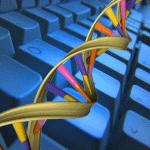Bioinformatics
|
21 august 2014 10:35:33 |
| Rubredoxin refolding on nanostructured hydrophobic surfaces: Evidence for a new type of biomimetic chaperones (Proteins: Structure, Function, and Bioinformatics) |
|
Tweet Rubredoxins (Rds) are small proteins containing a tetrahedral Fe(SCys)4 site. Folded forms of metal free Rds (apoRds) show greatly impaired ability to incorporate iron compared to chaotropically unfolded apoRds. In this study, formation of the Rd holoprotein (holoRd) upon addition of iron to a structured, but iron-uptake incompetent apoRd was investigated in the presence of polystyrene nanoparticles (NP). In our rationale, hydrophobic contacts between apoRd and the NP surface would expose protein regions (including ligand cysteines) buried in the structured apoRd, allowing iron incorporation and folding to the native holoRd. Burial of the hydrophobic regions in the folded holoRd would allow its detachment from the NP surface. We found that both rate and yield of holoRd formation increased significantly in the presence of NP and were influenced by the NP concentration and size. Rates and yields had an optimum at `catalytic` NP concentrations (0.2 g/L NP) when using relatively small NP (46 nm diameter). At these optimal conditions, only a fraction of the apoRd was bound to the NP, consistent with the occurrence of turnover events on the NP surface. Lower rates and yields at higher NP concentrations or when using larger NP (200 nm) suggest that steric effects and molecular crowding on the NP surface favor specific `iron-uptake-competent` conformations of apoRd on the NP surface. This bio-mimetic chaperone system may be applicable to other proteins requiring an unfolding step prior to cofactor-triggered refolding, particularly when over-expressed under limited cofactor accessibility. © Proteins 2014;. © 2014 Wiley Periodicals, Inc. |
| 142 viewsCategory: Biochemistry, Bioinformatics |
 Crystal structure of juvenile hormone epoxide hydrolase from the silkworm Bombyx mori (Proteins: Structure, Function, and Bioinformatics) Crystal structure of juvenile hormone epoxide hydrolase from the silkworm Bombyx mori (Proteins: Structure, Function, and Bioinformatics)Understanding the apparent stator-rotor connections in the rotary ATPase family using coarse-grained computer modelling (Proteins: Structure, Function, and Bioinformatics) 
|
| blog comments powered by Disqus |
MyJournals.org
The latest issues of all your favorite science journals on one page
The latest issues of all your favorite science journals on one page



